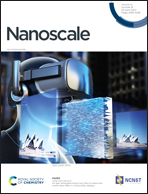Room-temperature developed flexible biomemristor with ultralow switching voltage for array learning†
Abstract
As one of the emerging neuromorphic computing devices, memristors may break through the limitation of traditional computers with a von Neumann architecture. However, the development of flexible memristors is limited by the high-temperature fabrication process, large operating voltage and non-uniform distribution of resistance. The room-temperature process has attracted great attention due to its advantages of low thermal dissipation, low cost and excellent compatibility with flexible electronics. Here, we proposed a fully physical vapour deposition (PVD) process for fabricating a memristor without additional heat treatment. The device showed excellent resistive switching characteristics with ultralow set/reset voltages (0.48 V/−0.39 V), uniform distribution (10%/15%), stable retention characteristic, multilevel storage behavior and reliable flexibility (radius of 10 mm). With continuously modulated conductance, typical synaptic plasticities were simulated by our flexible biomemristor, including excitatory post-synaptic current (EPSC), paired-pulse facilitation (PPF), long-term potentiation/depression (LTP/LTD) and learning-forgetting curve. Furthermore, the array learning behavior like that of the human brain was simulated with these trainable biomemristors. This study paves a new way for developing low-cost, wearable, neuromorphic computing electronics at room temperature and expands the applications of artificial synapse arrays.



 Please wait while we load your content...
Please wait while we load your content...